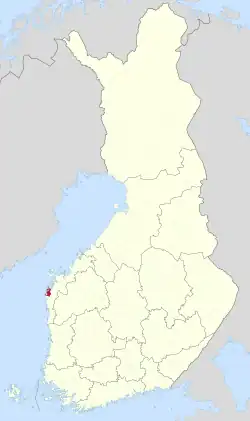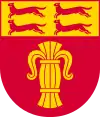Korsnäs | |
|---|---|
Municipality | |
| Korsnäs kommun Korsnäsin kunta | |
 | |
 Coat of arms | |
 Location of Korsnäs in Finland | |
| Coordinates: 62°47′N 021°11′E / 62.783°N 21.183°E | |
| Country | |
| Region | Ostrobothnia |
| Sub-region | Vaasa sub-region |
| Charter | 1887 |
| Government | |
| • Municipal manager | Christina Båssar |
| Area (2018-01-01)[1] | |
| • Total | 1,424.71 km2 (550.08 sq mi) |
| • Land | 236.27 km2 (91.22 sq mi) |
| • Water | 1,189.06 km2 (459.10 sq mi) |
| • Rank | 252nd largest in Finland |
| Population (2023-09-30)[2] | |
| • Total | 2,007 |
| • Rank | 257th largest in Finland |
| • Density | 8.49/km2 (22.0/sq mi) |
| Population by native language | |
| • Swedish | 84.3% (official) |
| • Finnish | 3.8% |
| • Others | 12% |
| Population by age | |
| • 0 to 14 | 14.5% |
| • 15 to 64 | 56.3% |
| • 65 or older | 29.2% |
| Time zone | UTC+02:00 (EET) |
| • Summer (DST) | UTC+03:00 (EEST) |
| Website | www |
Korsnäs is a municipality of Finland. It is located in the Ostrobothnia region.
Geography
Korsnäs is the most western mainland municipality in Finland. It covers an area of 1,424.71 square kilometres (550.08 sq mi) of which 1,189.06 km2 (459.10 sq mi) is water.[1]
It has a long, rocky coastline along the Gulf of Bothnia. The three largest islands are Halsön, Bredskäret and Södra Björkön, all used as important recreation areas for urban dwellers.[5]
Climate
Korsnäs has a subarctic climate (Dfc) with oceanic influences.
| Climate data for Korsnäs Bredskäret (1991–2020 normals, extremes 1993- present) | |||||||||||||
|---|---|---|---|---|---|---|---|---|---|---|---|---|---|
| Month | Jan | Feb | Mar | Apr | May | Jun | Jul | Aug | Sep | Oct | Nov | Dec | Year |
| Record high °C (°F) | 5.8 (42.4) |
6.2 (43.2) |
12.0 (53.6) |
18.3 (64.9) |
25.6 (78.1) |
28.2 (82.8) |
29.1 (84.4) |
29.1 (84.4) |
25.0 (77.0) |
16.2 (61.2) |
11.7 (53.1) |
7.4 (45.3) |
29.1 (84.4) |
| Daily mean °C (°F) | −3.9 (25.0) |
−5.0 (23.0) |
−2.5 (27.5) |
1.9 (35.4) |
7.8 (46.0) |
13.0 (55.4) |
16.4 (61.5) |
15.9 (60.6) |
11.6 (52.9) |
6.1 (43.0) |
1.7 (35.1) |
−1.5 (29.3) |
5.1 (41.2) |
| Record low °C (°F) | −38.1 (−36.6) |
−27.8 (−18.0) |
−24.7 (−12.5) |
−16.7 (1.9) |
−1.8 (28.8) |
3.8 (38.8) |
7.8 (46.0) |
7.4 (45.3) |
0.8 (33.4) |
−6.2 (20.8) |
−17.7 (0.1) |
−28.7 (−19.7) |
−38.1 (−36.6) |
| Source 1: FMI normals 1991-2020[6] | |||||||||||||
| Source 2: Record highs and lows[7] | |||||||||||||
History
Due to the post-glacial rebound, most of the area that today forms the municipality of Korsnäs stood under water until around 1000 A.D. The first settlement in Korsnäs is assumed to stem from the 13th century.[8] Some place names of Finnish origin (such as Molpe (Moikipää) and Taklax (Takalaksi)) indicate a Finnish-speaking presence in the 13th century, although it is disputed if these people (probably from Häme) only used the area for fishing on a seasonly basis[9] or if they established a proper, but sparse, settlement.[10] Swedish-speaking settlers came to the area in the 13th or 14th century.
Population
The municipality has a population of 2,007 (30 September 2023),[2] which make it the smallest municipality in Ostrobothnia in terms of population. The population density is 8.49 inhabitants per square kilometre (22.0/sq mi). The municipality is bilingual with Swedish as the majority language and Finnish as the minority language.[11] Until 2014 Swedish was the sole official language. 84.3% of the population speaks Swedish, 3.8% Finnish and 12% other languages as their first language.
Politics
In the 2017 Municipal elections Swedish People's Party got 95 percent of the vote, which obtained it each of the 21 seats of the municipality council.[12]
Name
Korsnäs is the municipality's official name in both Swedish and Finnish. The Finnish names Korsnääsi or Ristitaipale[13] are known to have been used historically in some contexts.
Korsnäs was first mentioned in historical documents is 1442, and some individual villages, like Molpe (then called Moikipä) was first mentioned in 1490, and Harrström (then called Harffuaström) in 1494. Korsnäs became an independent municipality in 1887. Prior to that, the area belonged to Närpes.[14]
References
- 1 2 "Area of Finnish Municipalities 1.1.2018" (PDF). National Land Survey of Finland. Retrieved 30 January 2018.
- 1 2 "Preliminary population statistics 2023, September". StatFin. Statistics Finland. Retrieved 26 October 2023.
- ↑ "Demographic Structure by area as of 31 December 2022". Statistics Finland's PX-Web databases. Statistics Finland. Retrieved 6 September 2023.
- ↑ "Population according to age (1-year) and sex by area and the regional division of each statistical reference year, 2003–2020". StatFin. Statistics Finland. Retrieved 2 May 2021.
- ↑ "Korsnäs". archipelago.nu. Archived from the original on 19 July 2001. Retrieved 13 October 2013.
- ↑ "FMI normals 1991-2020". fmi.fi. Retrieved 22 October 2023.
- ↑ "FMI open data". FMI. Retrieved 22 October 2023.
- ↑ Johan Ulfvens: "Korsnäsbor och korsnäsbyar". In: Korsnäs historia. Korsnäs 1981, pp. 9–25, p. 16.
- ↑ Olov Ahlbäck: "Österbottnisk medeltid". In: Svenska Österbottens historia I. Vasa 1977, pp. 45–56.
- ↑ Lars Huldén: "Vad berättar ortnamnen om den svenska bosättningens uppkomst i Finland?" In: Ann-Marie Ivars and Lena Huldén [eds.]: När kom svenskarna till Finland?. Helsingfors 2002, pp. 63–80, p. 69
- ↑ Korsnäsista ja Luodosta kaksikieliset kunnat, YLE 30 December 2014, accessed 1 January 2015.
- ↑ Kommunalval 2017, YLE resultattjänst, accessed 6 July 2019.
- ↑ See Archived 30 September 2007 at the Wayback Machine.
- ↑ "Tämä domain on varattu | www.matkailupohjanmaa.fi". www.matkailupohjanmaa.fi. Retrieved 6 May 2021.
External links
![]() Media related to Korsnäs at Wikimedia Commons
Media related to Korsnäs at Wikimedia Commons
